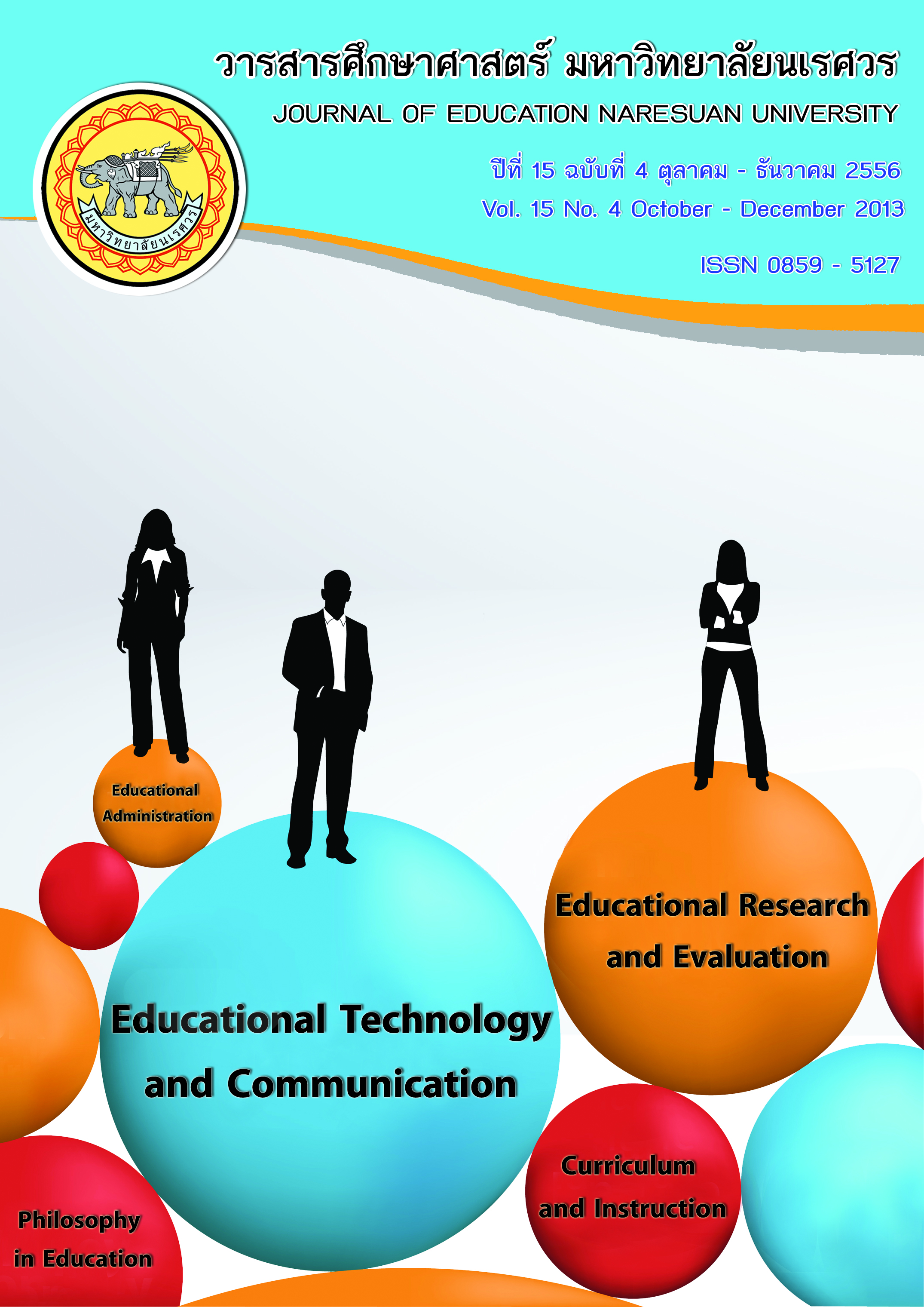การพัฒนากลยุทธ์การบริหารจัดการแหล่งเรียนรู้ของสถานศึกษาขั้นพื้นฐาน สังกัดสำนักงานเขตพื้นที่การศึกษาประถมศึกษากำแพงเพชร เขต 1 และเขต 2
Main Article Content
Abstract
บทคัดย่อ
การวิจัยนี้มีวัตถุประสงค์เพื่อ 1) ศึกษาสภาพ ปัญหา และความต้องการเกี่ยวกับการบริหารจัดการแหล่งเรียนรู้และศึกษาปัจจัยที่เกี่ยวข้องกับการบริหารจัดการแหล่งเรียนรู้ 2) พัฒนากลยุทธ์การบริหารจัดการแหล่งเรียนรู้ และ 3) ประเมินกลยุทธ์การบริหารจัดการแหล่งเรียนรู้ของสถานศึกษาขั้นพื้นฐาน สังกัดสำนักงานเขตพื้นที่การศึกษาประถมศึกษากำแพงเพชร เขต 1 และเขต 2 โดยดำเนินการวิจัย 3 ขั้นตอน คือ 1) ศึกษาสภาพ ปัญหาและความต้องการเกี่ยวกับการบริหารจัดการแหล่งเรียนรู้และศึกษาปัจจัยที่เกี่ยวข้องกับการบริหารจัดการแหล่งเรียนรู้ โดยสอบถามบุคลากรที่เกี่ยวข้องกับการบริหารจัดการแหล่งเรียนรู้ 3 กลุ่มได้แก่ ผู้บริหาร 201 คน ครูฝ่ายวิชาการ 201 คน และครูผู้สอน 346 คน และโดยการสนทนากลุ่ม จำนวน 2 ครั้งๆ ละ 12 คน รวม 24 คน 2) พัฒนากลยุทธ์การบริหารจัดการแหล่งเรียนรู้ด้วยการศึกษาสถานศึกษาที่บริหารจัดการแหล่งเรียนรู้ที่ประสบความสำเร็จ โดยสัมภาษณ์ ผู้บริหารสถานศึกษา จำนวน 5 คน ครูฝ่ายวิชาการ 5 คน และครูผู้สอน จำนวน 5 คน รวมทั้งสิ้น 15 คน การจัดประชุมเชิงปฏิบัติการจัดทำร่างกลยุทธ์ จำนวน 2 ครั้ง ๆ ละ 21คน รวม 42 คน และตรวจสอบความถูกต้องของกลยุทธ์โดยการสัมมนาอิงผู้เชี่ยวชาญ จำนวน 9 คน 3) ประเมินกลยุทธ์ที่ปรับปรุงแล้ว 4 ด้าน คือ ด้านความสอดคล้อง ด้านความเหมาะสม ด้านความเป็นไปได้และด้านการใช้เป็นประโยชน์ โดยใช้แบบสอบถามกับผู้เชี่ยวชาญ จำนวน 18 คน
ผลการวิจัยพบว่า
1. สภาพการบริหารจัดการแหล่งเรียนรู้ของสถานศึกษาขั้นพื้นฐาน สังกัดสำนักงานเขตพื้นที่การศึกษาประถมศึกษากำแพงเพชร เขต 1 และเขต 2 พบว่า สถานศึกษามีการนำข้อมูลมาใช้ในการวิเคราะห์สภาพแวดล้อมภายในและภายนอก มีหลักเกณฑ์การดำเนินงานที่ชัดเจน โดยการมีส่วนร่วมของผู้เกี่ยวข้อง มีการนำแผนปฏิบัติการไปสู่การปฏิบัติ มีการตรวจสอบประเมินผล มีการปรับปรุงและการพัฒนา มีการติดตาม แก้ไขการบริหารจัดการแหล่งเรียนรู้ที่ชัดเจน ส่วนปัญหา ได้แก่ ครูผู้สอนให้ความสำคัญในการวางแผนการบริหารจัดการแหล่งเรียนรู้ค่อนข้างน้อย การดำเนินงานโครงสร้างการบริหารจัดการแหล่งเรียนรู้ไม่สอดคล้องกับสภาพของโรงเรียน การติดตามและประเมินผล มีการจัดระบบการเก็บข้อมูลเพื่อตรวจสอบ ผลการประเมินไม่มีประสิทธิภาพ การปรับปรุงและการพัฒนา ไม่ได้นำผลการประเมินและข้อเสนอแนะมาใช้เป็นข้อมูลในการวางแผนพัฒนา
2. การพัฒนากลยุทธ์การบริหารจัดการแหล่งเรียนรู้ของสถานศึกษาขั้นพื้นฐาน สังกัดสำนักงานเขตพื้นที่การศึกษาประถมศึกษากำแพงเพชร เขต 1 และเขต 2 ดังนี้ 2.1) ผลการวิเคราะห์สภาพแวดล้อมพบว่า มีจุดแข็ง 13 ข้อ จุดอ่อน 15 ข้อ โอกาส 14 ข้อ และภาวะคุกคาม 12 ข้อ 2.2) กลยุทธ์ที่สร้างขึ้นประกอบด้วย วิสัยทัศน์ 4 พันธกิจ 4 ประเด็นกลยุทธ์ 4 เป้าประสงค์ 10 กลยุทธ์ 33 มาตรการ และ 41 ตัวชี้วัด
3. ผลการประเมินกลยุทธ์การบริหารจัดการแหล่งเรียนรู้ของสถานศึกษาขั้นพื้นฐาน สังกัดสำนักงานเขตพื้นที่การศึกษาประถมศึกษากำแพงเพชร เขต 1 และเขต 2 ในด้านความสอดคล้องของวิสัยทัศน์ พันธกิจ ประเด็นกลยุทธ์ เป้าประสงค์ กลยุทธ์ มาตรการ และตัวชี้วัด พบว่า มีความสอดคล้องกันในระดับมากและมากที่สุด และในด้านความเหมาะสม ความเป็นไปได้ และการใช้ประโยชน์ของกลยุทธ์ มาตรการและตัวชี้วัดมีผลการประเมินอยู่ในระดับมากและมากที่สุด
Abstract
The purposes of this research were 1) to study the status, problems, needs and factors in learning resource management, 2) to develop the strategies in learning resource management and 3) to evaluate the strategies in learning resource management of Schools under Kamphaeng Phet Primary Education Service Area Office 1 and 2. This research was divided into 3 phases as follows: 1) studying the status, problems, needs and factors in learning resource management. The data were obtained by using a questionnaire and the focus group discussion. Moreover enquiring 3 groups of personnel consisting of 201 administrators, 201 academic teachers and 346 teachers, 2) developing the strategies by studying the best practice of 5 high-achievement schools in learning resource management from 15 personnel consisting of 5 administrators, 5 academic teachers and 5 teachers by interview. Using SWOT analysis and making draft strategies in 2 workshops comprising of 21 people each. In addition, critics and comments from 9 experts were obtained, and 3) evaluating the readjusted strategies in 4 areas: consistency, propriety, feasibility and utility learning resource management of Schools under Kamphaeng Phet Primary Education Service Area Office 1 and 2 by using a questionnaire with 18 experts in strategies and administration.
The findings were as follows:
1. The status of learning resource management of Schools under Kamphaeng Phet Primary Education Service Area Office 1 and 2 were most realized, schools were using data to analyze the internal and external environments.There were clear guidelines for the participation of stakeholders in implementing the action plans into action. Also included are the monitoring of evaluation, improvements and the development of a monitoring solution for learning resource management. Problems, including the importance of teachers in the planning, management, and learning were so little.The management structure was inconsistent with the states of the schools. Monitoring and evaluation of the data collection systems were ineffective. The follow up and evaluation were ineffective in terms of data collecting systems. In terms of improvement and development, they were not carried out according to the assessment and recommendations.
2. The development of the strategies in learning resource management of Schools under Kamphaeng Phet Primary Education Service Area Office 1 and 2 was listed as follows: 2.1) The conditions analysis of learning resource management were 13 strengths, 15 weaknesses, 14 opportunities, and 12 threats. 2.2) Constructed strategies consisted of 4 visions, 4 missions, 4 goals, 4 strategic issues, 10 strategies, 33 measures, and 41 indicators.
3. Outcomes of the strategic assessment in the development of learning resource management of Schools under Kamphaeng Phet Primary Education Service Area Office 1 and 2 in terms of the consistency of visions, missions, goals, strategic issues, strategies, measures, and indicators were at a high and highest level of consistency. The consistency, propriety, feasibility and utility of strategies, measures, and indicators were at a high and highest level of assessment.Article Details
The owner of the article does not copy or violate any of its copyright. If any copyright infringement occurs or prosecution, in any case, the Editorial Board is not involved in all the rights to the owner of the article to be performed.


